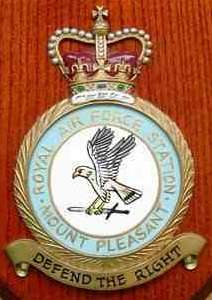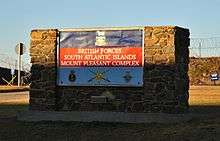RAF Mount Pleasant
| RAF Mount Pleasant | |||||||||
|---|---|---|---|---|---|---|---|---|---|
| East Falkland in the Falkland Islands | |||||||||
 | |||||||||
 EGYP Shown within Falkland Islands | |||||||||
| Coordinates | 51°49′22″S 058°26′50″W / 51.82278°S 58.44722°WCoordinates: 51°49′22″S 058°26′50″W / 51.82278°S 58.44722°W | ||||||||
| Type | Royal Air Force station | ||||||||
| Site information | |||||||||
| Owner | Ministry of Defence | ||||||||
| Operator | Royal Air Force | ||||||||
| Site history | |||||||||
| Built | 1985 | ||||||||
| In use | 1985 – present | ||||||||
| Airfield information | |||||||||
| Identifiers | IATA: MPN, ICAO: EGYP, WMO: 88889 | ||||||||
| Elevation | 74 metres (243 ft) AMSL | ||||||||
| |||||||||
RAF Mount Pleasant (IATA: MPN, ICAO: EGYP) (also known as Mount Pleasant Airport, Mount Pleasant Complex or MPA)[1] is a Royal Air Force station in the British Overseas Territory of the Falkland Islands. The airfield goes by the motto of "Defend the right"[2] (while the motto of the islands is "Desire the right") and is part of the British Forces South Atlantic Islands (BFSAI). Home to between 1,000 and 2,000 British military personnel, it is located about 30 miles (48 km) southwest of Stanley—the capital of the Falklands—on the island of East Falkland. The world's longest corridor, half a mile (800 m) long, links the barracks, messes and recreational and welfare areas of the station, and was nicknamed the "Death Star Corridor" by personnel.[3]
Mount Pleasant was opened by Prince Andrew on 12 May 1985, becoming fully operational the following year. The station was constructed as part of British efforts to strengthen the defence of the Falkland Islands following the 1982 war with Argentine forces. It remains the newest purpose-built RAF station and replaced previous RAF facilities at Port Stanley Airport.
History
RAF Mount Pleasant is the newest permanent airfield in the Royal Air Force.[4] The RAF previously had a small airfield at Stanley airfield after the end of the hostilities in 1982. During the Falklands War when the islands were occupied by Argentine military forces, British aircraft were sent to disable the runway with RAF Strike Command Vulcan bombers (Operation Black Buck) and Royal Navy Sea Harriers. The raids were moderately successful, and on the first Black Buck mission one 1,000-pound (450 kg) bomb hit the runway in the middle, disabling it. However, temporary repairs by the Argentines did allow C-130 Hercules transport aircraft to bring in supplies and take out casualties until the end of the conflict. At the end of hostilities the runway was fully repaired by British military engineers.

After the surrender of the Argentine ground forces on the islands, the British still faced the problem of potential Argentine air attacks from Argentina, so an aircraft carrier had to remain on station to guard the islands with its squadron of Sea Harriers until the local airfield was prepared for jet aircraft. HMS Hermes was the first to take guard duty, whilst HMS Invincible went north to change (at sea) a main engine.[5] Invincible then returned to relieve Hermes which urgently needed to return to the UK for boiler cleaning. Invincible returned until she was relieved by the newly built HMS Illustrious, which was quickly rushed south and commissioned during the journey. Once the Port Stanley runway was available for jets, Illustrious was relieved by four RAF F-4 Phantom FGR.2 (named 'Faith', 'Hope', Charity' and 'Desperation' by the crews – the first three named after the three Gloster Gladiators that according to legend were the names of the three RAF fighters defending Malta in the Second World War).
The British government felt that Stanley airfield was not the best option for a large, permanent station and decided to construct a new RAF station and make it the centrepiece of considerably strengthened air defences for the Falkland Islands, South Georgia and the South Sandwich Islands. This was intended to deter any future Argentine attempts to take the islands by force. Mount Pleasant, to the west of Stanley, was chosen as the site for the new station. The construction, which had extraordinary challenges to get materials on site, was undertaken by a Laing-Mowlem-ARC consortium.[6] The airfield was opened by Prince Andrew (who served in the Falklands War) on 12 May 1985,[7] and became fully operational in 1986.[8]
Flights of Phantoms were rotated through the airfield until 1992 when they were replaced with Tornado F3s. The Tornado was replaced by the Eurofighter Typhoon in September 2009. These have been supported throughout by C-130s and, since 1996, VC10s, equipped for aerial refuelling, transport, search and rescue and maritime patrol.
A flight of Westland Sea King helicopters for support and search and rescue was located at Mount Pleasant from November 2007 until April 2016.
As of April 1, 2016, with the worldwide retirement of Westland Sea King the Islands search and rescue function has been replaced by a commercial organisation, AAR, subcontracting the services to British International Helicopters for 10 years using two new AgustaWestland AW189s
Operations and facilities
RAF Mount Pleasant has a wide range of social and sporting facilities including a gym, swimming pool, golf course, diving centre, kart racing, Laser Quest, library, cinema, bowling, climbing wall and indoor and outdoor sports pitches. As of August 2010 it has the only cricket ground in the Falklands. There are two NAAFI shops, hairdressers, a medical centre, and an education centre on the station. BFBS Radio also maintains a live local station on the site. There is also a complex that includes a Costa Coffee café and a small shop, which are both owned and run by the Falkland Islands Company.[9]
Currently located at Mount Pleasant are No. 905 Expeditionary Air Wing, No. 1435 Flight with four Eurofighter Typhoons, No. 1312 Flight, with a single Voyager tanker/transport and one Hercules. There are also two Sikorsky S-61 civilian Helicopters run by British International Helicopters Limited (Brintel). Ground units include No 7, 303, and 751 Signals Units and a Rapier detachment from the Royal Artillery. This was previously handled by the RAF Regiment but the RA now have sole responsibility for operating the Rapier.
33 Engineer Regiment (EOD) provides constant support and is part of the Joint Service Falkland Islands Detachment which consists of RAF and RLC EOD teams. It is mainly located in Stanley but there is also a detachment at Mount Pleasant. The group's role is to destroy unexploded munitions from the Falklands War; to brief troops, tourists and citizens on which areas are safe; and to mark uncleared minefields.[10]
There is also a Joint Communications Unit (JCU) providing the electronic warfare and command and control systems for the Royal Navy, British Army and Royal Air Force.[11]
Prince William served as a Sea King pilot on the station for six weeks during February and March 2012.[12]
Flying units located at RAF Mount Pleasant
- No. 1435 Flight – 4 x Eurofighter Typhoons
- No. 1312 Flight – 1 x Voyager KC2,[13] 1 x Hercules C3
Formerly No. 1564 Flight – 2 x Sea King HAR3s, replaced by 2 x AW 189 Helicopters (private company).[14][15]
Airlines and destinations

Using the IATA airport code MPN, RAF Mount Pleasant also acts as the Falkland Islands' only international airport, along with its military role. Flights open to civilian passengers are operated twice each week. The Hercules C-130 Transport Force operating out of RAF Lyneham supplied a direct non-stop service from RAF Lyneham via Ascension, Wideawake Airfield. From Ascension the flight was direct involving in-flight refuelling from a C-130 tanker. The flight duration was usually about 12 hours down and 13 hours back. The last scheduled flight in the world involving in-flight refuelling to the Falklands was carried out by a crew of 24 sqn in C-130 XV291 during the period 18–23 March 1989. This was the 650th and last of its type carried out by RAF Lyneham C-130s. Flights were then operated directly by the RAF using the Lockheed TriStars of 216 Squadron. Starting in autumn 2008,[16] these flights were operated on behalf of the Royal Air Force by a civilian airline, Flyglobespan. Since the airline's bankruptcy in 2009, the flights have been operated by Air Tahiti Nui, Titan Airways, Air Seychelles and Hi Fly.[17] The service is now operated by AirTanker using Airbus Voyager aircraft.[18] They fly to and from RAF Brize Norton in Oxfordshire, with a refuelling stop at RAF Ascension Island in the south-central Atlantic Ocean. These flights previously used a Boeing 767 aircraft but the current aircraft is an Airbus A330. Occasionally a RAF Boeing C-17 freight aircraft or the Antonov An-225 are employed to bring in large items of freight.
Additionally, every Saturday LAN Airlines operates a scheduled commercial flight to Presidente Carlos Ibáñez del Campo International Airport of the Punta Arenas city in southern Chile, stopping at Río Gallegos, Argentina once a month.
On 2 March 2012, the Argentinian President Cristina Fernández de Kirchner called for Aerolineas Argentinas flights to Buenos Aires to replace LAN Airlines flights to Chile. The idea of flights to Argentina was not supported in the islands, because this might result in Argentina having a monopoly on commercial flights and controlling all commercial air access.[19][20]
On 2 April 2012, a Uruguayan air company, Air Class Líneas Aéreas, gained permission from the Uruguayan Ministry of Defence to start a commercial flight to the Falkland Islands.[21]
Flights are planned to Saint Helena when a new airport there opens in 2016.[22]
Scheduled
| Airlines | Destinations |
|---|---|
| LATAM Chile | Punta Arenas, Rio Gallegos, Santiago |
| Royal Air Force operated by AirTanker | RAF Brize Norton, RAF Wideawake |
Unscheduled
| Airlines | Destinations |
|---|---|
| FIGAS | Stanley, other settlements on the Falklands |
| Hi Fly | London-Gatwick, Sal |
See also
- List of Royal Air Force stations
- List of Royal Air Force aircraft squadrons
- Mare Harbour
- Military of the Falkland Islands
References
- ↑ Falkland Islands Information Portal
- ↑ Photo of an RAF Mount Pleasant plaque
- ↑ "Brigadier David Nicholls". Telegraph.co.uk. 22 July 2006.
- ↑ "RAF Mount Pleasant". Royal Air Force. 2012. Retrieved 1 June 2012.
- ↑ "British Bases - Falklands War 1982". naval-history.net.
- ↑ "About the Falklands". Ministry of Defence. Retrieved 4 June 2012.
- ↑ "RAF Timeline 1980–1989". Royal Air Force. 2012. Retrieved 2 February 2012.
- ↑ Falkland Islands Government
- ↑ Falkland Islands HIVE
- ↑ Royal Engineers
- ↑ Royal Corps of Signals
- ↑ Bates, Stephen (10 November 2011). "Prince William to go to Falklands next year". London: The Guardian. Archived from the original on 22 December 2011. Retrieved 23 December 2011.
- ↑ http://www.ainonline.com/aviation-news/2014-03-26/raf-retires-tristar-tankers-voyager-fleet-grows?utm_source=dlvr.it&utm_medium=twitter
- ↑ https://twitter.com/Chf_Eng_Air/status/715406532859441152
- ↑ http://forces.tv/33996444
- ↑ "Falkland Wool Growers Report for Week Ending 16 July 2004 - Falkland Islands News". sartma.com.
- ↑ Archived 4 February 2010 at the Wayback Machine.
- ↑ "AIR-BRIDGE MAINTENANCE". Press release. Falkland Islands Government. 24 April 2014. Retrieved 26 June 2014.
- ↑ Goni, Uki (2 March 2012). "Argentine president calls for direct flights from Falklands to Buenos Aires". The Guardian. London.
- ↑ "Argentina wants its airline to fly to Falklands". Reuters. 2 March 2012.
- ↑ "Green light for Uruguayan flight to Falklands; Argentine ambassador says it's not commercially viable". MercoPress.
- ↑ "Planning for when the 2016 airport, St Helena after closer links with Faklands". MercoPress.
External links
![]() Media related to RAF Mount Pleasant at Wikimedia Commons
Media related to RAF Mount Pleasant at Wikimedia Commons
- World Aero Data – RAF Mount Pleasant
- James Rogers and Luis Simón. The Status and Location of the Military Installations of the Member States of the European Union and Their Potential Role for the European Security and Defence Policy (ESDP). Brussels: European Parliament, 2009. 25 pp.
- MPA Falklands Memoirs 1983–1986 Memoirs of the construction of the airfield at Mount Pleasant.

